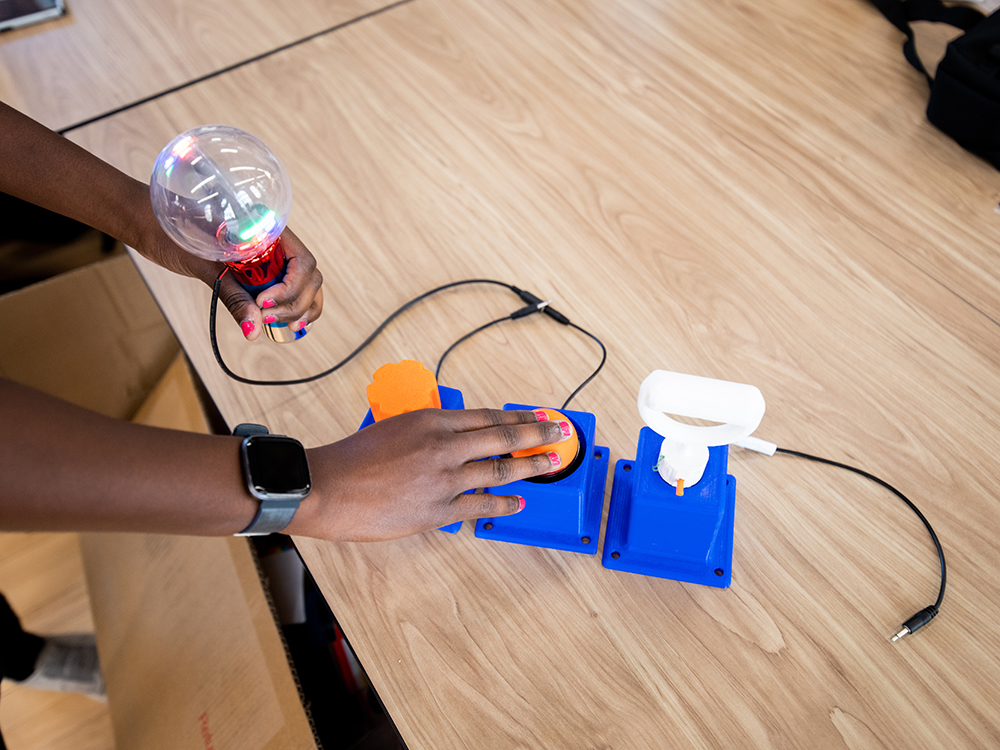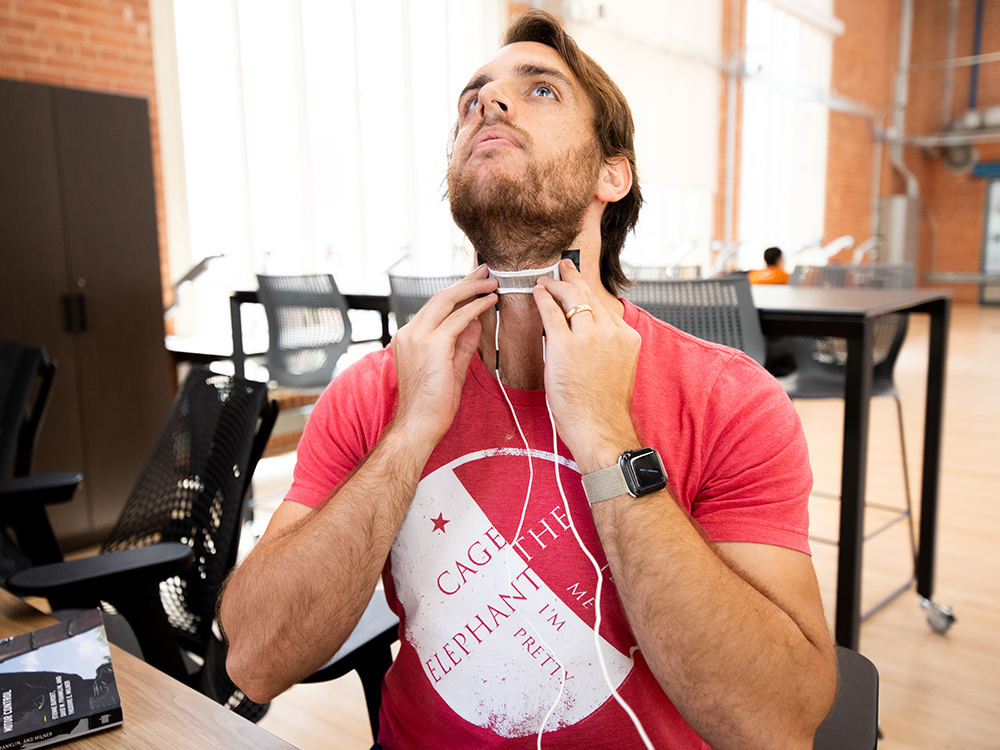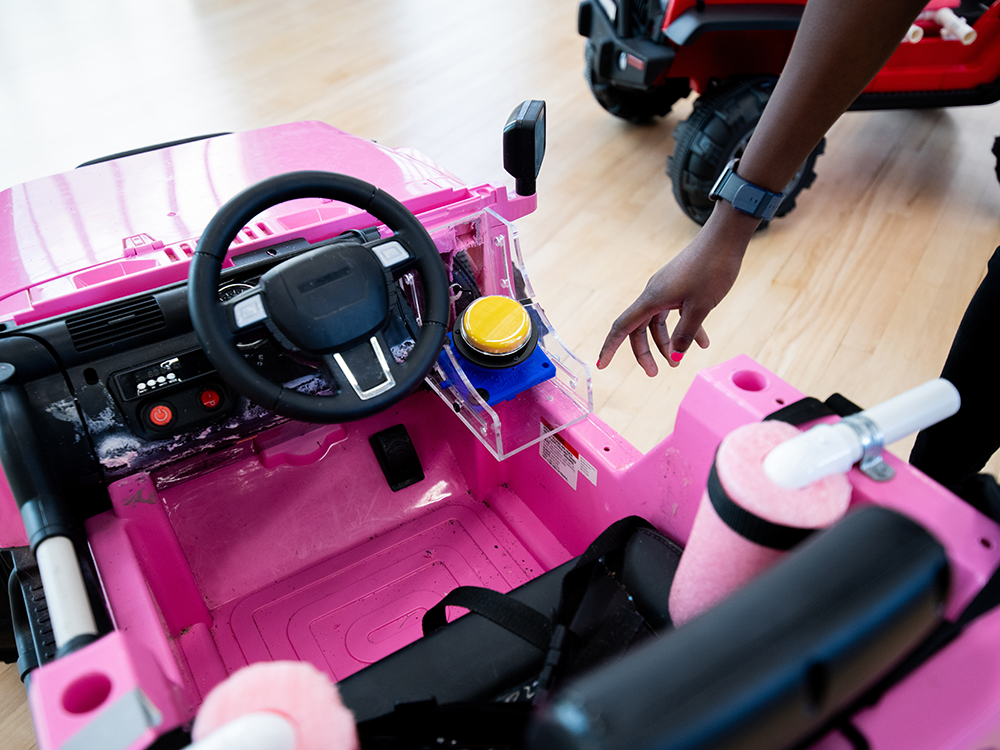In May 2020, Sulzer’s 4-year-old daughter, Livie, was struck by a tree branch. She suffered a traumatic brain injury (TBI) from the incident. And since then, the family has worked tirelessly, not just to take care of their daughter, but also to shine a light on gaps in care for families dealing with TBI.
The family has been candid in telling their story. Sulzer is an assistant professor in the Walker Department of Mechanical Engineering focused on rehabilitative technology, and his wife, Lindsay, is the chief technology officer of a medical device company. This family is as well-situated as anyone to handle TBI, and still it has been a struggle.

Together they authored a research paper earlier this year, laying out their experiences in painstaking detail. The paper has made waves, shaking up how researchers think about rehabilitative tech.
And last month, The Atlantic published a detailed profile of the family, introducing the world to Livie and their journey to this point.
Their experience has led to an outpouring of support across campus. It has galvanized students determined to come up with solutions to help Livie and others recover from TBI. And it has motivated Sulzer and others to re-think their approach to rehab tech research.
"Despite the fact that so many people need solutions like these, it's a new field and an opportunity to work on something that will make lives better," said Drake Rowland, a master's student in mechanical engineering, who began working on projects over the summer.
More than 30 students have stepped up to participate in these projects. And many of them are undergraduates getting a rare opportunity to not only do research early in their careers but to work directly with the person they are designing solutions for. A diverse group of faculty members within the Cockrell School and across campus are also lending their expertise to some of these projects. That group includes:
- José del R. Millán, a professor in the Cockrell School's Department of Electrical and Computer Engineering specializing in brain-machine interfaces
- Corinne Jones, assistant professor of neurology at Dell Medical School and a speech language pathologist
- Jonathan Chen, a professor in the College of Natural Sciences focused on textiles
- Amy Bryan, an associate professor and expert in early childhood development
- Joydeep Biswas, assistant professor of computer science, who specializes in autonomous mobile robots
- Francisco Gonzalez-Lima and Andreanna Haley, psychology professors focused on neuroscience, and Rajinder Koul, a professor in the Department of Speech, Language, and Hearing Sciences in the Moody School of Communication, provided advice on guidance on clinical care for Livie
This group has come together to help their colleague, but that's not the only goal. They are also working with rehab facilities in Austin to design new tools that will help other people recovering from similar injuries.
"Because of this experience I want to take pediatric rehab and make it part of my research going forward," Sulzer said. "These projects won't just be one-off things for Livie; I want to develop them and carry them forward. But it's just the beginning for all of that, and research is like a big ship, and it takes years to steer it."


Here are a few of the projects that Sulzer, the students and faculty have been working on:
Livie doesn't walk right now, and she spends approximately an hour each day in a stander. That's meant to keep bones and joints strong. But while standing, it's unclear if she's favoring one limb or side of the body of another or leaning too much on supports. In order to make sure she is putting weight on her feet evenly, the team crafted a pair of foot sensors that measure how much force is put on each one. A heat map tells the user where weight is being distributed, and it can be monitored via an app.
Timmy Pollard-Grayson, a mechanical engineering junior was one of the first students to work on this project. A 3D-printing enthusiast, Pollard-Grayson had never before worked on a physical therapy device, and that experience has been rewarding for him.
"I really enjoy going over to their house and testing with Livie because you get to see what works and what doesn't in real time, and it's a chance to affect someone's life," he said.
A swallowing sensor the team is working on is designed to let the family know that Livie is regularly clearing her throat. Chen's lab made the fabric for the device, a thin layer of silver-coated yarn. When you stretch it, the resistance changes and creates a signal that can be measured to indicate a "swallowing event." This is necessary because aspiration, which is the technical term for when something "goes down the wrong pipe" when eating or drinking, is a leading cause of death among people with cerebral palsy and similar conditions to Livie.
The fabric for the swallow sensor is also being used on another project. This one adapts an existing system created by other researchers for stimulating hand movement in patients who have suffered strokes. Livie has trouble opening her left hand but can open her right hand. The device will stimulate the weaker hand when the strong hand opens, making them open at the same time.
Modified ride-on cars are very popular in cases of TBI in kids because they are more approachable for other kids than a powered wheel chair and better for socialization. Sulzer and the students are working on several different versions of modified ride-on cars that can also be used as therapy devices. For Livie, they have outfitted a pink Jeep with different types of buttons and levers to make the car move. These can be removed and used with other adapted toys as well, giving her an option that is both fun and improves her grip.
Another ride-on car project began as a senior capstone project and has gone through several iterations. It is being made for a child receiving treatment at the NAPA Center, a new physical therapy/occupational rehabilitation facility in Austin. It requires different supports and buttons than Livie's car.


Sulzer and the students are broadening their work with these ride-on cars even further. One of the students this summer plans to start a UT Austin chapter of GoBabyGo, an organization that aims to increase mobility and quality of life solutions for children who need them. This well help them develop modified ride-on cars for disabled kids all over Austin and beyond.
"One of the most important things I've learned working on these projects is that different kids have different needs, and that’s going to be really important as we work on solutions for more kids." said Seun Fashina, a second-year mechanical engineering master's student, who is leading the work on ride-on cars.
This collection of projects is just the beginning of Sulzer’s new research direction. Students are designing new gait trainers, developing advanced assessment methods for visual impairment, creating devices to activate weak muscles based on activity measured from less impaired muscles and brain activity and adapting additional toys for use in local pediatric rehabilitation centers.
In bringing together researchers from different disciplines, Sulzer aims to build a broader rehabilitation community and integrate that with the organization he founded in 2014, the Cellular to Clinically Applied Rehabilitation Research and Engineering (CARE) Initiative. The topics of these projects and inclusion of the local rehabilitation community are additionally the subject of his rehabilitation engineering course this spring. The hope is that not only will Sulzer be able to improve the quality of life for his daughter, but this community approach will highlight the gaps in rehabilitation that the family experienced. And they will give students the tools, and first-hand experience, to create tech that will actually help people.






